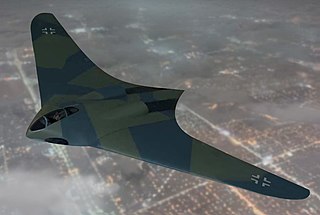
The Horten H.IX, RLM designation Ho 229 was a German prototype fighter/bomber designed by Reimar and Walter Horten to be built by Gothaer Waggonfabrik. Developed at a late stage of the Second World War, it was one of the first flying wing aircraft to be powered by jet engines.
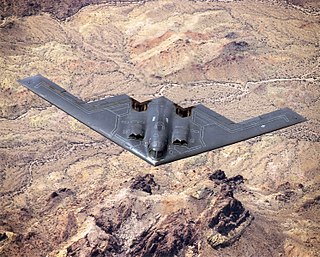
A flying wing is a tailless fixed-wing aircraft that has no definite fuselage, with its crew, payload, fuel, and equipment housed inside the main wing structure. A flying wing may have various small protuberances such as pods, nacelles, blisters, booms, or vertical stabilizers.

The Henschel Hs 132 was a World War II dive bomber and interceptor aircraft of the German Luftwaffe that never saw service. The unorthodox design featured a top-mounted BMW 003 jet engine and the pilot in a prone position. The Soviet Army occupied the factory just as the Hs 132 V1 was nearing flight testing, the V2 and V3 being 80% and 75% completed.
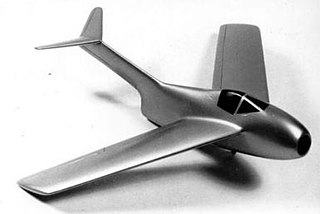
The Focke-Wulf Ta 183 Huckebein was a design for a jet-powered fighter aircraft intended as the successor to the Messerschmitt Me 262 and other day fighters in Luftwaffe service during World War II. It had been developed only to the extent of wind tunnel models when the war ended, but the basic design was further developed postwar in Argentina as the FMA IAe 33 Pulqui II. The name Huckebein is a reference to a trouble-making raven from an illustrated story in 1867 by Wilhelm Busch.
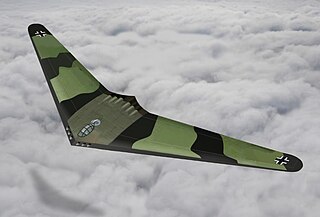
The Horten H.XVIII (18) was a proposed German World War II intercontinental bomber, designed by the Horten brothers. The unbuilt H.XVIII represented, in many respects, a scaled-up version of the Horten Ho 229, a prototype jet fighter. The H.XVIII was one of many proposed designs for the Langstreckenbomber, and would have carried sufficient fuel for transatlantic flights.

The Messerschmitt P.1112 was a proposed German jet fighter, developed by Messerschmitt AG during the closing stages of World War II, and intended for use by the Luftwaffe. The progress of the war prevented the completion of a prototype before the fall of Nazi Germany. Its design, however, had a direct influence on postwar US Navy carrier fighters.

The Heinkel He P.1079 was a projected German V-tail all weather jet fighter designed by Heinkel Flugzeugwerke in the closing stages of World War II. The aircraft was only a design; it was not produced.

The Arado E.381 was a proposed parasite fighter aircraft. Conceived by Arado Flugzeugwerke in December 1944 for Germany's Luftwaffe during World War II, the E.381 was to have been carried aloft by and launched from an Arado Ar 234 "mother" aircraft. It would then have activated its rocket engine, which would have propelled it to attack Allied bombers. Development was cancelled due to lack of funds and official support.
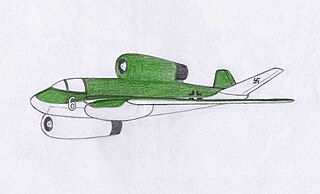
The Heinkel P.1073, known also as Strahljäger, was a fighter project developed for the Luftwaffe by Heinkel aircraft manufacturing company during the last years of World War II.
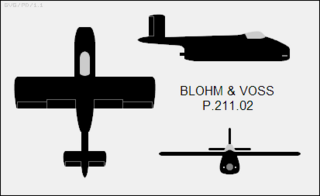
The Blohm & Voss P 211 was a design proposal submitted by Blohm & Voss to the Volksjäger jet fighter competition of the Luftwaffe Emergency Fighter Program towards the end of the Second World War.
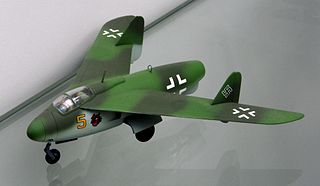
The Junkers EF 128 was a project for a single-engine jet fighter, developed for the Emergency Fighter Program Luftwaffe design competition during the Second World War.

The Messerschmitt P.1110 was a design for a single-seat, high-altitude interceptor, prepared for the German Luftwaffe by the Messerschmitt aircraft manufacturing company, under the Emergency Fighter Program during the last months of World War II.

The Messerschmitt P.1099 was a two-seat prototype jet plane designed by Messerschmitt for the Luftwaffe before the end of the Second World War.

The Focke-Wulf Volksjäger, was a German emergency fighter project for the Luftwaffe. It was designed by Focke-Wulf towards the end of World War II as part of the defense effort against the devastating Allied bombing raids.

The Messerschmitt P.1079 was a series of pulsejet-powered Messerschmitt fighter projects during the Second World War. The P.1079 aircraft designs were to be powered by pulse jets, the same engines used in the V-1 flying bomb.
The Blohm & Voss P215 was an advanced jet night fighter project by Blohm & Voss during the Second World War. With a crew of three and twin jet engines, it featured a tailless swept-wing layout and heavy armament. An order for three prototypes was received just weeks before the war ended.
The Blohm & Voss P 209 was one of a series of single-engined jet fighter design studies. Under development in the latter half of 1944, when the single-engined jet fighter requirement was issued the P 209 was radically revised to meet the deadline but was not taken further by the RLM.
The Lippisch Delta VI was a proposed single-seat, twin-jet experimental delta flying wing aircraft begun in 1943 by German designer Alexander Lippisch, as the developed version of the P.11 bomber project begun while he was still working for Messerschmitt in 1942. The only prototype was destroyed in June 1944 while still under construction.

The Messerschmitt Me 262 was a German World War II fighter aircraft built by Messerschmitt in the later stages of the war, and under license by Avia post-war.

















